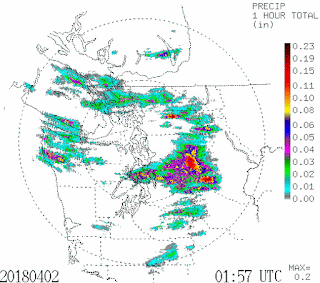And it was a convergence zone with serious consequences, leading to dozens of accidents, the closure of I-90, and the death of a woman and her unborn child.
As a reminder, a Puget Sound convergence zone forms when low-level westerly/northwesterly flow on the Washington Coast is forced to move around the Olympics and then convergences over Puget Sound. Such low-level convergence forces upward motion, clouds and precipitation that stretches from the Sound to west side of the Cascades (see figure).
Convergence zones really rev up when two things occur: (1) an unstable atmosphere, in which temperature cools rapidly with height, and (2) an environment with upward lift.
We had both of them last time. The air aloft was very cold....in fact, the air at 5000 ft (850 hPa) was near record levels. This is illustrated by the figure below, which shows the climatology of 850 hPa temperatures at Quillayute, on the WA coast. The blue line shows the record lows for the date and the gray circle was the observed value yesterday at 5 PM. Pretty much tied the record cold for the date at that level!
And there was very strong general lift from a well defined upper level trough moving into the region (see the 500 hPa...about 18K foot...map at 8 PM Sunday).
The visible satellite imagery at 6 PM yesterday showed a classic convergence zone signature. You can see the thin enhanced band over Puget Sound that widens and stretches towards the Cascades. The classic clear areas to the north and south of the band was evident-- due to sinking air in the lee of the Cascades and mountains of Vancouver Island. And percolating, unstable air offshore (you can see the convective clouds). Just perfect.
The convergence zone was very evident in weather radar imagery. Here are some 1-h precipitation totals based on radar data... you can see the band of convergence precipitation over the Sound and the HUGE enhancement on the western slopes of the Cascades.
Some lighting was produced by the relatively deep cumulonimbus associated with the convergence zone. The lightning detection network showed on strike right over Seattle (see below)
You could get a great view of the situation from the Space Needle PanoCam. Looking south, the clear zone was evident.
But turning 180 degrees to the north one was viewing the jaws of deep clouds and heavy rain.
With very cold air aloft (about -6C at 850 hPa....5000 ft), we started with a very low snow level (around 1000 ft). So getting snow in the passes was no problem. Snoqualmie got hit hard, with 16.5 inches of new snow reported. The pass closed last night and was still closed....as spinning out cars and tracks blocked passage.
But with such a low snow level and heavy precipitation, snow pushed down to lower elevations, and started covering I 90 down to North Bend (see image from Eastside Fire Rescue). Dozens of accidents occurred, including the terrible fatality crash noted earlier.
And near sea level, there was a number of heavy "soft hail" and graupel (small while ice particle) showers that turned the ground white in places.
The threat of a convergence zone was clear earlier during the day, as was the low snow level. Here is a forecast of the 3-h precipitation ending 8 PM Sunday, from the UW WRF model run made 5 AM Sunday morning. Not bad.
Seeing this situation, I believe we need to find a way to provide folks with better real-time warnings when this kind of situation occurs, including the use of WSDOT reader boards to slow traffic way down when such features occur. People tend to drive too fast when such inclement weather occurs and WSDOT and my profession need to build an infrastructure that will warn drivers and force them to slow before this hit weather hazards such as heavy rain, loss of visibility, roadway ice, and snow on the roadway. Next week there will be a WSDOT idea session and I will try out some ideas with them.
_________________________________________________________
Announcement: The Northwest Weather Workshop is on April 27-28
The NW Weather Workshop is the big annual meeting for those interested in Northwest meteorology. This year we will have a major session on the meteorology of NW wildfires and others on other aspects of our regional weather. The gathering takes place at the NOAA facility in Seattle. To view the agenda and to register, go to the meeting website. The workshop is open to everyone, but registration is required.
from Cliff Mass Weather and Climate Blog https://ift.tt/2EdjGbX













No comments:
Post a Comment